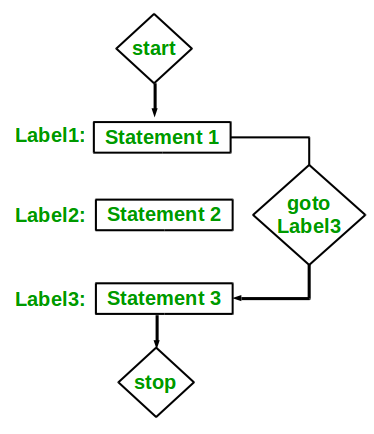如果满足某些条件,则使用跳转语句来操纵程序的流程。它用于终止或继续程序内部的循环或停止函数的执行。在C++中,有四个跳转语句: continue , break , return和goto 。
继续:它用于执行循环的其他部分,同时跳过条件内声明的某些部分,而不是终止循环,而是继续执行同一循环的下一次迭代。它与决策语句一起使用,该决策语句必须存在于循环内部。该语句可以在for循环或while或do-while内使用 环形。

语法:
continue;程序1:
考虑一个场景,其中所有数字1到10之间(数字5除外)。因此,在这种情况下,想法是在i的值为5之后使用continue语句。以下是相同的程序:
C++
// C++ program to demonstrate the
// continue statement
#include
using namespace std;
// Driver code
int main()
{
for (int i = 1; i < 10; i++) {
if (i == 5)
continue;
cout << i << " ";
}
return 0;
} C++
// C++ program to demonstrate the
// break statement
#include
using namespace std;
// Driver Code
int main()
{
for (int i = 1; i < 10; i++) {
// Breaking Condition
if (i == 5)
break;
cout << i << " ";
}
return 0;
} C++
// C++ program to demonstrate the
// return statement
#include
using namespace std;
// Driver code
int main()
{
cout << "Begin ";
for (int i = 0; i < 10; i++) {
// Termination condition
if (i == 5)
return 0;
cout << i << " ";
}
cout << "end";
return 0;
} C++
// C++ program to demonstrate the return
// statement in void return type function
#include
using namespace std;
// Function to find the greater element
// among x and y
void findGreater(int x, int y)
{
if (x > y) {
cout << x << " "
<< "is greater"
<< "\n";
return;
}
else {
cout << y << " "
<< "is greater"
<< "\n";
return;
}
}
// Driver Code
int main()
{
// Function Call
findGreater(10, 20);
return 0;
} C++
// C++ program to demonstrate the
// goto statement
#include
using namespace std;
// Driver Code
int main()
{
int n = 4;
if (n % 2 == 0)
goto label1;
else
goto label2;
label1:
cout << "Even" << endl;
return 0;
label2:
cout << "Odd" << endl;
} 1 2 3 4 6 7 8 9
中断:如果满足条件,则用于终止整个循环。与满足条件后的continue语句不同,它会中断循环,并且循环的其余部分不会执行。 Break语句与决策语句一起使用,例如if,if-else ,或者 转变 在for循环内的语句,可以是for循环, while循环或do-while循环。它强制循环停止进一步迭代的执行。

语法:
break;程式2:
考虑一种情形,在该情形中,要打印一系列数字,但不遵循某个特定值K。因此,在这种情况下,想法是在i的值为K之后使用break语句。以下是相同的程序:
C++
// C++ program to demonstrate the
// break statement
#include
using namespace std;
// Driver Code
int main()
{
for (int i = 1; i < 10; i++) {
// Breaking Condition
if (i == 5)
break;
cout << i << " ";
}
return 0;
}
1 2 3 4
返回值:它使控制权脱离函数本身。它比休息强。它使用该函数的执行之后或一些条件后到终止整个函数。每个函数都有一个return语句,带有除void()函数之外的一些返回值。尽管void()函数也可以具有return语句以结束该函数的执行。

语法:
return expression;程序3:
下面是演示return语句的程序:
C++
// C++ program to demonstrate the
// return statement
#include
using namespace std;
// Driver code
int main()
{
cout << "Begin ";
for (int i = 0; i < 10; i++) {
// Termination condition
if (i == 5)
return 0;
cout << i << " ";
}
cout << "end";
return 0;
}
Begin 0 1 2 3 4
解释:
上面的程序通过打印“ Begin”开始执行,然后for循环开始打印i的值,它将打印i的值(从0到4),但是一旦i等于5 ,它将终止整个函数,即永远不会去打印程序的“ end”语句。
void()函数中的return可以不带任何return类型地使用。
句法:
return;计划5:
下面是演示函数的return声明为void返回值的程序:
C++
// C++ program to demonstrate the return
// statement in void return type function
#include
using namespace std;
// Function to find the greater element
// among x and y
void findGreater(int x, int y)
{
if (x > y) {
cout << x << " "
<< "is greater"
<< "\n";
return;
}
else {
cout << y << " "
<< "is greater"
<< "\n";
return;
}
}
// Driver Code
int main()
{
// Function Call
findGreater(10, 20);
return 0;
}
20 is greater
Goto :此语句用于直接跳转到要调用它的程序部分。每个goto语句都与标签相关联,该标签将它们带到调用它们的程序的一部分中。标签语句可以写在程序中任何地方,无需在goto语句之前或之后使用。该语句很难理解程序的流程,因此避免在程序中使用它。

句法:
goto label_name;
.
.
.
label_name:
计划6:
下面是演示goto语句的程序:
C++
// C++ program to demonstrate the
// goto statement
#include
using namespace std;
// Driver Code
int main()
{
int n = 4;
if (n % 2 == 0)
goto label1;
else
goto label2;
label1:
cout << "Even" << endl;
return 0;
label2:
cout << "Odd" << endl;
}
Even
说明:上面的程序用于检查如果用户按下的数字为4 ,则该数字是偶数还是奇数,因此if语句满足条件,并且控制转到label1 , label1打印该数字为偶数。在这里,没有必要在goto语句之后编写标签语句,我们可以在goto语句之前编写它,这样也可以正常工作。